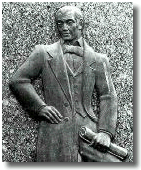Felipe Enrique Neri, Baron de Bastrop
| Felipe Enrique Neri Baron de Bastrop | |
|---|---|
 Monument of Baron de Bastrop in Bastrop County, Texas. | |
| Native name | Baron de Bastrop |
| Born |
Philip Hendrik Nering Bögel November 23, 1759 Paramaribo, Surinam |
| Died |
February 27, 1827 (aged 67) Saltillo, Mexico |
| Resting place | Saltillo |
| Known for |
Louisiana land development Texas colonization partnership with Stephen F. Austin |
| Spouse(s) | Georgine Wolffeline Françoise Lijcklama à Nyeholt |
| Children | Five |
| Parent(s) |
Conraed Laurens Nering Maria Jacoba (Kraayvanger) Bögel |
Felipe Enrique Neri (born Philip Hendrik Nering Bögel; November 23, 1759 in Paramaribo, Surinam – 23 February 1827) was a Dutch businessman and land owner known for his assistance in Anglo-American settlement of Texas.
Early life and family
Bastrop was born Philip Hendrik Nering Bögel and changed his name when he moved to San Antonio, Texas. He was the son of Conraed Laurens Nering and Maria Jacoba (Kraayvanger) Bögel. In 1764, he moved to the Netherlands with his parents and later joined the cavalry. Neri married Georgine Wolffeline Françoise Lijcklama à Nyeholt in Oldeboorn, Friesland on April 28, 1782. Together, they had five children. They later settled in Leeuwarden, Friesland, where Neri worked as a tax collector.[1]
Flight to North America
Neri was accused of using tax funds for personal gain in 1793, so he left his family and fled to Spanish Louisiana before he could go to court. In Louisiana, Neri introduced himself as a Dutch nobleman, Baron de Bastrop. People believed his false identity, and Neri was soon engaged in many land deals where he made a fortune but later went broke. He received permission from Spain to form a colony in the Ouachita River valley.[1] His contract with Spanish colonial governor Francisco Luis Héctor de Carondelet provided for European settlement of 850,000 acres on the Ouachita. Although ninety-nine colonists settled in the area, the project was halted when Louisiana realized its government treasury did not have enough funds to see the colonization to fruition.[2]
Career in Texas
When Louisiana's sale from France to the United States was finalized, he moved to Texas and received a permit to establish a colony between Bexar and the Trinity River. He moved to San Antonio in 1806, where he posed as a loyal subject who strongly opposed the sale of Louisiana to the USA. In 1810 he was appointed second alcalde, (mayor or chief judicial official), of the Spanish town.
In 1820, Neri met with Moses Austin, whose request to bring Anglo-American settlers into Texas had recently been rejected. He had been acquainted with Moses Austin, having formerly shared the hospitality of a roadhouse in then-Spanish Missouri with Moses 20 years before he came to Texas. Neri used his influence to help Moses Austin, and later Stephen F. Austin obtain grants to bring Anglo-American settlers into Texas, later to be called the Old Three Hundred.[1]
In 1820, Neri was chosen to be commissioner of colonization for Stephen F. Austin’s colony. In 1823, he was elected to the provincial deputation of San Antonio, and later the Legislature of Coahuila y Tejas in 1824. Until his death on February 23, 1827, he served the legislature. He did not leave enough money for his burial, so other legislative members paid for it. In his will, he left land to his wife and children in the Netherlands. Years later, his true identity was revealed.
Legacy
Neri was a very important and influential person in the colonization of Texas. Without him, Texas might have never been populated with Anglo-American settlers.[1]
The following places are all named after him:
- Bastrop, Louisiana
- Bastrop County, Texas
- Bastrop, Texas
- De Bastrop Township, Ashley County, Arkansas[3]
References
- 1 2 3 4 Moore, Richard W. "Baron de Bastrop". Handbook of Texas Online. Texas State Historical Association. Retrieved 8 August 2011.
- ↑ Rodriguez, Junius P (2002). The Louisiana Purchase: A Historical and Geographical Encyclopedia. ABC-CLIO. pp. 26, 27. ISBN 978-1-57607-188-5.
- ↑ Dickinson, Samuel Dorris (Summer 1989). "Colonial Arkansas Place Names". Arkansas Historical Quarterly. XLVIII: 159. Retrieved 20 July 2016.
3. http://www.historischcentrumleeuwarden.nl/html/nl/1464/Baron_de_Bastrop
Sources
- Moore, Richard W. Bastrop, Baron de, Handbook of Texas Online.
- The Baron de Bastrop, The Institute of Texan Cultures
- Rogers, Tex; American History, The Old 300, Electric Scotland
- Bastrop, Lone Star Internet
- Felipe Henique Neri Baron de Bastrop, Flickr.com
